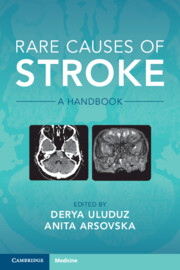Book contents
- Rare Causes of Stroke
- Rare Causes of Stroke
- Copyright page
- Contents
- Contributors
- Preface
- 1 Inflammatory Conditions
- 2 Infectious and Postinfectious Vasculitis
- 3 Hypercoagulable Causes of Stroke
- 4 Drug-Related Stroke
- 5 Hereditary and Genetic Causes of Stroke
- Chapter 5.1 Genetic Collagen Disorders
- Chapter 5.2 Genetic Small-Vessel Diseases
- Chapter 5.2 Chapter
- Chapter 5.3 Genetic Metabolic Diseases
- 6 Rare Causes of Cardioembolism
- 7 Vasospastic Conditions and Other Vasculopathies
- 8 Other Non-inflammatory Vasculopathies
- 9 Venous Occlusive Conditions
- 10 Bone Disorders and Stroke
- Index
- References
Chapter 5.2 - Chapter
from 5 - Hereditary and Genetic Causes of Stroke
Published online by Cambridge University Press: 06 October 2022
- Rare Causes of Stroke
- Rare Causes of Stroke
- Copyright page
- Contents
- Contributors
- Preface
- 1 Inflammatory Conditions
- 2 Infectious and Postinfectious Vasculitis
- 3 Hypercoagulable Causes of Stroke
- 4 Drug-Related Stroke
- 5 Hereditary and Genetic Causes of Stroke
- Chapter 5.1 Genetic Collagen Disorders
- Chapter 5.2 Genetic Small-Vessel Diseases
- Chapter 5.2 Chapter
- Chapter 5.3 Genetic Metabolic Diseases
- 6 Rare Causes of Cardioembolism
- 7 Vasospastic Conditions and Other Vasculopathies
- 8 Other Non-inflammatory Vasculopathies
- 9 Venous Occlusive Conditions
- 10 Bone Disorders and Stroke
- Index
- References
Summary
The chapter gives overview of a very rare progressive genetic multi-organ small-vessel disease affecting retina and brain, but also otherhighly vascularized organs, mostly kidneys and liver. Retinal vasculopathy with cerebral leukoencephalopathy and systemic manifestations (RVCL-S) is inherited in autosomal dominant manner and caused by heterozygous C-terminal frameshift mutation in TREX1 gene.The clinical phenotype is largely based on details from an international study in less than 100 mutation carriers from 11 unrelated families. Clinically RVCL-S hasremained under-recognized. The vascular retinopathy is presented from age 20, followed by liver and kidney disease, and clinical manifestations of global and focal brain dysfunctionaround age 50 and leading to death in 10-15 years. On magnetic resonance imaging white matter lesionscan be confused withcentral nervous system tumours, multiple sclerosis,or other inherited small vessel diseases with prominent white matter lesions. There is no established treatment for RVCL-S
Keywords
- Type
- Chapter
- Information
- Rare Causes of StrokeA Handbook, pp. 240 - 245Publisher: Cambridge University PressPrint publication year: 2022

